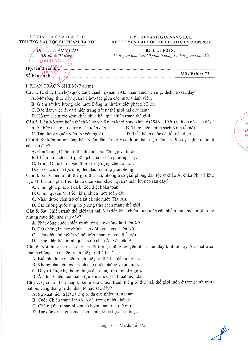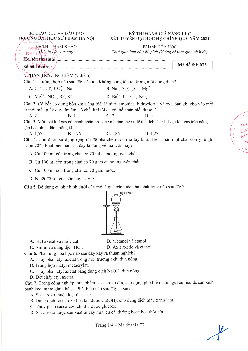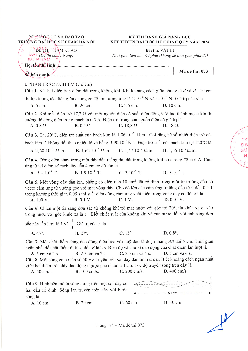
TRUdfl@/,,
Hgilap
r4,lF.trhp.
s6 HA
Nfih,..
o
}J
o
DE TIII
s0
crAo
DUC vA DAo rAo
TRU.ON r r{oc
su'PrraM
rrA \Qr
ri rrrr oAru
crA
x,f,rc lu'c
xET TUvEN DAr
rloc ItE
csixs
et-iv
xAvt zozr
KHAO
Birithi:
TIENG ANH
Thdi
gian
lam bdi:
60
phtit
(kh6ng
k€ thoi
gian phdr
di)
trang)
Me de thi: 073
NGHTEM VA CAU TRA
Lor NGAN
(8
diem)
GRAMMAR
Mark lhe letter A, B, C, or
D on
your
onswer
sheet to
indicate tlte correct onswer
to eaclt of
the
following
questions.
1. Yesterday,
when I
_
dinner,
my best friend
came over.
A. am cooking
B. was cooking
C.
have cooked
D. willcook
2.
_sun
is shining. Let's
go
out
for a
walk, shall
we?
A. A
B. An
C. The
D. @
(no
article)
3. The Secrel Island
is
_
than
the other books
you
mentioned.
A. as
popular B. more
popular
C.
popular D. the most
popular
4.
HanoiNational
University of
Educatior,
_
is
one
of the leading
universities
in Vietnam, attracts
thousands ofstudents
each
year.
A.
whose
B.
where
C.
which
D. that
5.
We
for
over
ten hours
without a break.
Let's
call it a day!
A.
will work
B. have been
working C.
worked
D. are
working
6.
How do
you
manage
in this heat
without air
conditioning?
A.
to live
B. living
C.
live
D. lived
7. Taxi
drivers are advised
to
get
their car
engines
on a
monthly basis
to ensure
they
work
properly.
A. check
B. checked
C. to
check
D. checking
8.
If it had not been
for his approval
of those
residential
projects, the
mayor in
prison
now.
A. isn't
B.
won't
be
C.
wouldn't be
D.
wouldn't have been
9. The
lives of thousands
of fish
are
_
jeopardy
as a
result of
the recent oil
spill.
A. under
B. on
C. at
D.
in
VOCABULARY
Mark the letter
A, B, C,
or D on
your
answer
sheet to
indicote
the cotect
answer
to eoch
of the
following
questions.
10. My
sister is
good
at
preparing like
chicken
soup or
fish.
A.
parties
B.
dishes
C. events
D. desserts
11. You cannot
find these
animals
anywhere
else.
They
are very
A. dangerous
B.
wild
C.
popular
D. rare
12. The main
goal
of
the
ASEAN
is to
peace
in the
area.
A.
promote
B. admit
C. remove
D.
join
13.
The economic
downturn
since
the onset
of
the Covid
pandemic has
caused
millions
of
with
the bankruptcy
of businesses.
A. abundance
B. redundancies
C.
reductions
D. unemployment
14. Most
future houses
will
be
designed
to consume
energy
-,
saving
money
in
the end.
A. efficiently
B. traditionally
C. heavily
D. wastefully
C
1F
9l
S\
\
()
Trang 114
-MadC
thi 073

15. This famous
author has
a
_
personality.
He really
cares for others.
A. separate
B.
private
C.
warm
D.
strong
16. The
boy's favourite activity
alter school is
_
a walk in the
park
near his home.
A.
picking
up
B.
going
for
C.
looking for
D. taking up
17. I don't know
much about the history
ofthe desert; I
just
know that it was
_
after Simpsonin 1929.
A. looked
B.
chased C. taken D.
named
18. The
organization a choice
to donate books to the charity last Christmas.
A. made
B. did
C. took D. had
19. She is said to
be
a woman
of her If she says something,
she'll do it.
A. letter
B.
promise
C.
word
D. speech
READING
PASSAGE
I
Read tlte
following
possoge
and mark the letter A, B, C, or D on
))our
onswer sheet
to
indicate
the
correct onswer to euclt
of the
questions.
Many intercultural families involve
the
negotiation
of different
cultural traditions.
They must adopt,
or adapt
to,
elements of a different culture. This
process
can sometimes
be
fraught.
Our cultural
background
provides
us
with
a set of expectations about how things work in the world. Negotiating
different elements of this worldview requires understanding and acceptance, and often compromise.
Dom
and her twin sister Gen
grew
up with a
blending of
their mum and dad's cultural traditions. Their
mum is
of
European
heritage and their dad is Indian, but she
grew
up in Singapore. As a family, they
celebrated Christmas and Deepavali. At Christmas, they had a roast lunch and
presents.
They also
celebrated
Deepavali or Diwali, as it is sometimes called,
with a family
meal
and
a
prayer.
They
had
sparklers too because it is the Festival of Light. On birthdays, they
ate Prasad,
an Indian sweet.
But
she doesn't recall her
parents
struggling with cultural differences. Their
parents
want them to
pick
and
choose what they wanted from each culture.
Chloe
and Matt had
to
navigate their
different
cultural heritages in the
planning
of
their wedding. They
had to
bring Chloe's Chinese
and Matt's Italian backgrounds together so
that they and
both
families
were happy with. The couple wanted a
'Western
style' service
in a church. Yet, Chloe's mum was
uncomfortable with that and
suggested
the
'Eastern'
side ofthe
family.
So,
they included the traditional
Chinese tea ceremony in the reception. Usually
it takes
place
on the morning of the
wedding with
family members,
but
the couple decided to do it at the
wedding reception instead. Chloe says when she
spoke to
guests,
they had loved it.
In many intermarried families, the merging of
cultural traditions happens
most around the dinner table.
Eliza
remembers
lots of stories
about cooking
when
she
was
growing
up. Her mum, from
Trinidad and
Tobago,
still
makes traditional food for their
family. At Christmas, instead of
roast ham for lunch, they
would have it for breakfast. She
would cut it up
with
tomatoes
and lots
of
traditional spices.
Mum
would always
try to
get
them to eat more spices,
Eliza admits.
"She's
got
this
jar
of
spicy sauce and
it's too spicy for the rest of us. She
puts it on her food and she
asks us if we want some too.
We're
like,
'no
no no no!' So she'd say to us,
'you're
not
proper
black children.' She's
like,
'it's
your
white
side coming out'," Eliza laughs. She says
her dad is of
British heritage.
Although navigating cultural differences
in
family life can be challenging, successful
intermarriages
have some common factors. One
is shared
values; another is a common
faith.
Openness
towards
difference and the ability to compromise
are also important.
(Adapted
from
scanloninstitute.org.au)
i
t
)
Trang
214
-t/rld6
thi 073

20.
What does
the
word
'it'
in
paragraph
2 refer
to?
A. Christmas
B. Diwali
C. A family meal
D.
An Indian
sweet
21. How did
Chloe adapt
the tea ceremony
to make both families happy?
A. They had
it at Chloe's
mum's.
B. They had
it with their family
members.
C. They had it
on the morning
of the wedding.
D. They
had it at the wedding
reception.
22.
At Christmas, what
did Eliza and
her family have for
breakfast?
A. Roast ham
B.
Spicy food
C. Grilled tomatoes
D.
Christmas
puddings
23. Which
of the following is
closest in meaning to the
phrase
'we're
like'
in
paragraph
4?
A. We like each
other.
B. We look similar.
C. We reply to mum.
D.
We have the same opinion.
PASSAGE 2
Read
the
following
passage
and mark the
letter A, B, C, or D on
your
answer sheet to indicate
the
correct answer
to eoch of the
questions.
Not much is known
about the saola, a mysterious horned mammal native to forests in
the Annamite
Mountains
of Laos and
Vietnam.
The
species
was
unknown to Western science until 1992, when
researchers
encountered
saola
horns
in the
home
of a local hunter. Scientists have only managed to
record
a saola in the wild five times
-
and only
with
camera traps. At least one thing seems fairly
certain, though: The saola is a
very
endangered
species.
Adult
saolas are about 33 inches tall
at the shoulder, but
they
can
weigh 220 pounds,
and their two
long
horns can
grow
to 20 inches.
Smaller
than most cattle and
bison,
they have managed
to hide from
humans
better than
other
animals at
their size.
They are likely the world's largest land animal that has
never been seen in the wild
by a biologist.
Even so, they are still suffering the effects
of
human's
presence.
Hunting is
the main danger to the saolas, even
though most hunters in the
species'
range have little
interest in killing or capturing them. Unlike many other animals
in
their
habitat, the
saolas
are not
featured in the traditional
Chinese
pharmacopeia,
so there isn't much financial
incentive
for hunters
to
target saolas for export. The species' meat is
not considered especially appealing compared with other,
more common
ungulates in the same
forests, like muntjacs or sambar deer, so they are not highly
valued as bushmeat, either. Nonetheless, they're often
incidentally killed amid the
general pursuit
of
other wildlife.
Some saolas
fall
victim to bushmeat
hunters, but the main threat comes from wire traps
set by
professional poachers.
Another major
threat
to the saola is a familiar one for wildlife
all
over
the world: the loss and
fragmentation
of
its habitat. The development of the Ho ChiMinh
Highway has already affected saola
populations
by fragmenting forests as
well as by increasing human access for logging,
hunting, and
spiriting wildlife away to urban markets. The
road has also led to more deforestation
in
several
key
areas for the
saola, especially the
Hue Saola Nature Reserve
and
Quang
Nam Saola Reserve. The
high
growth
rate in human
populations
will
likely add to the
pressures
already fueling the saola's decline.
Trang 314
*l/r1,
dC thi 073
I
')
r
tll
)l
c
:--/

People have
been trying to capture
saolas about 20 times
since 1992. Unfortunately,
all have died
shortly afterward except for
two that were released
back into the
wild.
There are
currently no captive
saolas anywhere, and
thus no backup
for
wild
populations.
If a captive
breeding
program
can't
be
established
before the last
wild
saolas fade
away, the species will be lost forever.
(A
d apte d
fro
m h
t tp s : //w wtu. t re e hu
gge
r.
co
nt)
24.
What is the
passage
mainly
about?
A. A study
on a
mysterious
animal
B. An
endangered species
C. Extinction caused
by
loss
of habitat
D. A
captive breeding
program
25.
Which of the following is NOT true
according to the
passage?
A.
It
is hard to observe saolas in nature.
B.
Saolas are valuable to
poachers.
C. Many saolas' deaths are
caused by the
poachers'traps.
D. The road
construction has caused habitat destruction.
26. What does the word
"fueling"
in
paragraph
4 mean?
A.
Using coal or oil
B.
Burning
C. Stimulating
D. Hindering
27.What
can be inferred about the
saola captive breeding
program?
A.
It
has never been successful.
B. It was successful only
once.
C. It hasn't been carried
out
yet.
D. It has helped increase the
saola
population.
WORD FORMATION
Complete the text
below
witlt the correctform of the words in capitals.
The
Hoi An Lantern Festival
is
a
rnonthly
(28)
of the full 28. CELEBRATE
moon in Vietnam. The full moon is one
of
the most sacred times
in
the Buddhist calendar. During this time,
people
all
over
Asia
observe
(2e)
and worship their ancestors. This is done
in rnany 29. RITE
ways, from
offerings made at family shrines
to the burning of incense
and the lighting
of candles.
These traditions have
gradually
morphed
into the
(30)
Hoi An Lantern
Festival. As the name 30. DELIGHT
31.
QUESTTON
suggests, lantern lighting is
(31)
a festival highlight.
Multi-coloured lanterns
are lit with candles and
placed
on
the
Thu Bon River
with
a
wish
for all
good
things. The festival
is
(32)
_
held on the exact date ofthe
full moon, but it has been
recently organized on the l4th day of the
lunar calendar each month.
(Ad
ap te d
fro
nx www. onthe
go
to ur s. co m)
rr. PHAN
Tr/
LUAN
(2
diem)
WRITING
33. Write
a
paragraph
(of
approximately 150
words) about the following topic:
Do
you
prefer
to study at a university abroad or
in
your
country? Explain
your
choice.
32. HISTORY
Trang
414
-}/rd,
dC thi 073
)
Bấm Tải xuống để xem toàn bộ.




